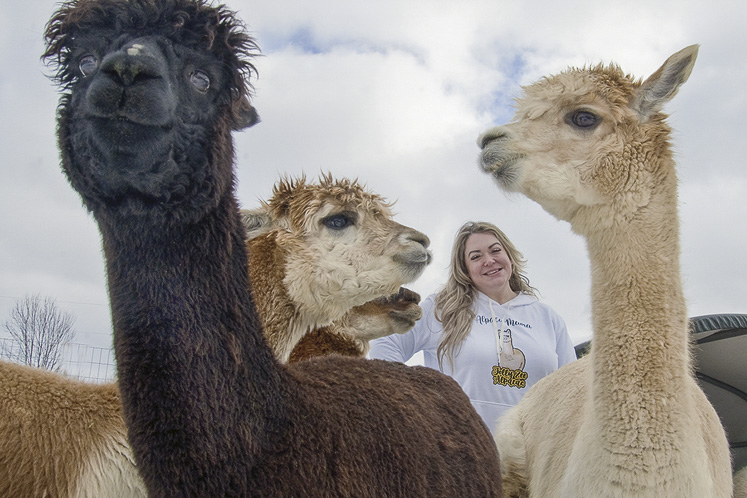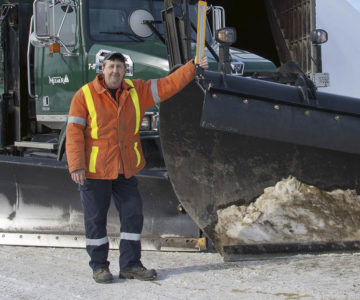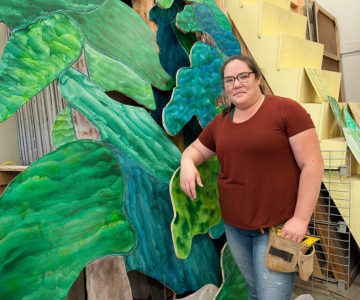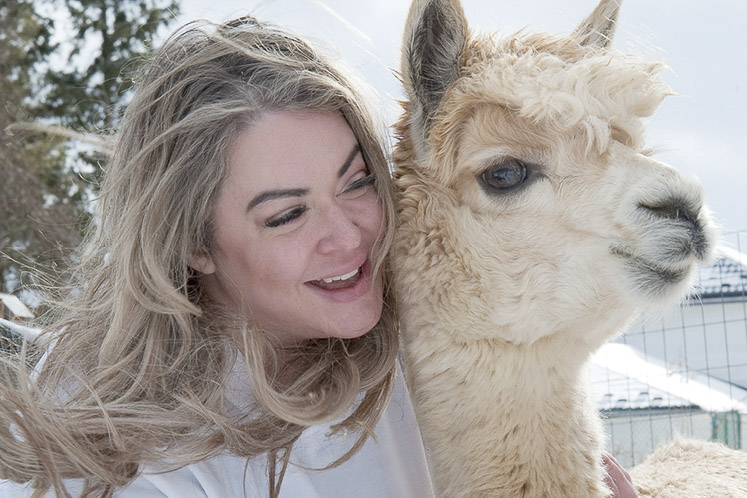The Alpaca Whisperer
Julie Broadbent spends her days tending to her herd of 10 fuzzy, rambunctious characters.
Owning a small herd of alpacas was part of Julie Broadbent’s life plan. But the 10 wide-eyed female alpacas, currently taking turns loping over to monitor our chat, showed up in her life a little earlier than she’d envisioned.
Growing up in Toronto and Mississauga, Julie always hoped to live on a farm surrounded by animals – especially alpacas – but filed the notion away under “retirement plans,” as she pursued a career as a commercial and wedding photographer. Then Covid brought weddings to a screeching halt in 2020.
After much research and volunteering with alpacas, Julie was given two – friendly reddish Ginger and stately white Serena – by an alpaca outfit she worked with. She promptly started her business, Jolly Zee Alpacas, in 2021 on a property in Caledon, offering experiential tours, walks, picnics and other pandemic-friendly activities. In 2022 she moved her herd to merge with another herd of more than 100 at the 40-acre Mimosa Springs Alpacas farm in Hillsburgh. The farm is run by Julie’s “barn family,” Anna and Michael Dehn (Michael also happens to be the mayor of Erin), and the trio shares the work, taking shifts with the animals. Julie lives in south Acton, a quick 20-minute commute.

Julie Broadbent with four of her beloved alpacas – Tansy, Evita, Sanjee (just her nose) and Ginger. Photography by Rosemary Hasner.
And now that weddings are back in full force? Julie says shovelling manure and helping with shearing now take priority, but she still accepts some wedding and portrait clients – especially those looking for rustic settings that come with a few unconventional, yet darling co-stars.
9 a.m. Julie is out the door and on the road to Hillsburgh before the alpacas expect breakfast. It’s wakeup time for the alpacas – well, some of them. Alpacas, who live outdoors, don’t all sleep at the same time. As herd animals, some are always awake, instinctively taking turns keeping watch. “They say you should always have at least three alpacas,” Julie says with a laugh. “One to look left, one to look right and one to sleep.”
Though alpacas – members of the camelid family that originated in the Andes – have only been in North America for less than 40 years, she says, they’ve made their mark. “People are really taken with them,” says Julie. “Like dogs, alpacas show empathy and are often friendly.” As if on cue, the brown, buck-toothed Lily, her youngest and most affectionate, comes over for a quick hello.
The alpacas, naturally vegan, are excited for their breakfast of feed pellets, hay and, as a special treat, alfalfa. Heads down and fluffy alpaca rumps in the air, they home in on their individual feed buckets.
10 a.m. It’s free time – for the alpacas. At Mimosa Springs, there are separate fenced-off areas for babies (called crias) and nursing moms, young males, older males, females and rescue animals; the farm takes in about one every month, usually because an owner can’t take care of it.
“You really need to do your research before getting an alpaca. They’re herd animals, so they’ll be lonely on their own. Unless you are set up to breed, getting just a male and a female is not a great idea,” says Julie, because you’d have to separate them. And they need pasture. “An alpaca’s favourite thing to do is graze.” Six alpacas typically require a half to full acre.
While the alpacas graze, Julie is on poop patrol. “Alpacas each poop four pounds a day. When the manure isn’t frozen over the winter, I’m shovelling for three to four hours a day from the communal dung piles.” (Thankfully, the manure makes a rich compost for gardening.)
1 p.m. It’s time for a welcome break. Come summer there will be no such luxury because the farm is likely to be hosting one of multiple daily tours. These are Julie’s domain while Anna is the specialist in alpaca care and fibre. Plans are underway to build a fibre mill on site. Not only is alpaca fibre incredibly warm, but it is also hypoallergenic and antimicrobial, she says.
Watching the alpacas run and play provides high entertainment. The term “pronking” describes the playful, bouncing run that provokes giggles from visitors. Even better is the soft, whiskery nuzzle of an alpaca nibbling pellets from an outstretched hand. The hour-long tour includes cuddly bunnies, leaping goats and other farm mates.
3 p.m. It’s time to clean the feed pans and water troughs. On summer Saturdays Julie is booked for wedding photography and her mother, Linda, takes over the tours. “She’s been so much help,” Julie says. “She also assists when all hands on deck are required, like for shearing, vet visits, vaccinations, nail clipping or teeth filing.”
What was that, ask the alpacas? Yes, teeth filing. (Teeth filing is necessary because alpacas’ only teeth, bottom teeth, continue to grow in adulthood.) None of these activities are fun, so the alpaca farmers try to bundle the tasks. It’s a four-day event at the end of May or early June. An experienced shearer visits the farm. Julie and the Dehns perform the vaccinations at the same time. They were trained by their large-animal vet. “It’s a bit stressful. We don’t look forward to this time of year, but it’s a necessary evil for the animals’ health and wellness.”
4 p.m. Julie works with her two original alpacas, Ginger and Serena, walking them with a harness and lead. These two came to Julie as therapy animals and walk on the lead for visits to hospitals or seniors’ centres. “Serena has been in elevators and cars, travelling to various locations,” she says. “Alpacas have an incredible ability to calm people and bring them happiness.”
Julie plans to expand her mental health-related services this year. She speaks from personal experience. Six-and-a-half years ago her infant daughter died, and Julie found herself struggling. “I wanted to learn everything I could about alpacas. I knew they would help me.”
6 p.m. It’s dinner, which means more fresh water, pellets and lots of high-quality hay to last all night long. The nights are still cold, so Julie may put horse blankets on the alpacas that are very young or old, or those with thinner coats.
7 p.m. After saying goodnight to all the animals, Julie heads home, where she often enjoys a quiet evening in. She is finally where she always hoped she would be – in the country, surrounded and fulfilled by her animals and a new farm family.
Related Stories

Bring It On!
Nov 20, 2022 | | A Day in the LifeWhen the winter wind blows and the flakes fly, snowplow operator Bruce Crawford is ready to go to work.

Jigsaws and Routers and Drills, Oh My!
Sep 20, 2022 | | A Day in the LifeTheatre Orangeville’s technical director, Lisa Lahue, gets her hands dirty as she helps create the imagined worlds that enchant theatregoers.









